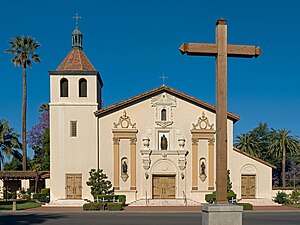Mission Santa Clara

Mission Santa Clara
|
|
|
Location in the Santa Clara Valley
|
|
| Location | 500 El Camino Real Santa Clara, California 95053 |
|---|---|
| Coordinates | 37°20′57″N 121°56′30″W / 37.349269°N 121.9416°WCoordinates: 37°20′57″N 121°56′30″W / 37.349269°N 121.9416°W |
| Name as founded | La Misión Santa Clara de Asís |
| English translation | The Mission of Saint Clare of Assisi |
| Founding date | January 12, 1777 |
| Founding priest(s) | Father Presidente Junípero Serra |
| Founding Order | Eighth |
| Military district | Fourth |
|
Native tribe(s) Spanish name(s) |
Bay Miwok, Tamyen, Yokuts Costeño |
| Native place name(s) | Socoisuka |
| Baptisms | 8,536 |
| Marriages | 2,498 |
| Burials | 6,809 |
| population | 1,125 |
| Secularized | 1836 |
| Governing body | Santa Clara University; Roman Catholic Diocese of San Jose |
| Current use | University of the chapel; Parish church |
| Reference no. | #338 |
| Website | |
| www |
|
Mission Santa Clara de Asís is a Spanish mission founded by the Franciscan order in the present-day city of Santa Clara, California. The mission, the eighth in California, was founded on January 12, 1777 and named for Saint Clare of Assisi, the foundress of the order of the Poor Clares. It is the namesake of both the city and county of Santa Clara, as well as Santa Clara University, which was built around the mission. This was the first California mission to be named in honor of a woman and the only one now located on a university campus.
Although ruined and rebuilt six times, the settlement was never abandoned, and today it functions as both a parish church of the Diocese of San Jose and a university chapel for Santa Clara University.
The outpost was originally established as La Misión Santa Clara de Thamien (or Mission Santa Clara de Thamien, a reference to the Tamyen people) at the Indian village of So-co-is-u-ka (meaning "Laurelwood", located on the Guadalupe River) January 12, 1777. There the Franciscan brothers erected a cross and shelter for worship to bring Christianity to the Ohlone and Costanoan peoples. Floods, fires, and earthquakes damaged many of the early structures and forced relocation to higher ground. The second site is known as Mission Santa Clara de Asís. A subsequent site of the mission dating from 1784 to 1819 is located several hundred yards west of the De La Cruz overpass of the Caltrain track; moreover, several Native American burial sites have been discovered near this subsequent site. The current site, home to the first college in Alta California, dates back to 1828.
...
Wikipedia

